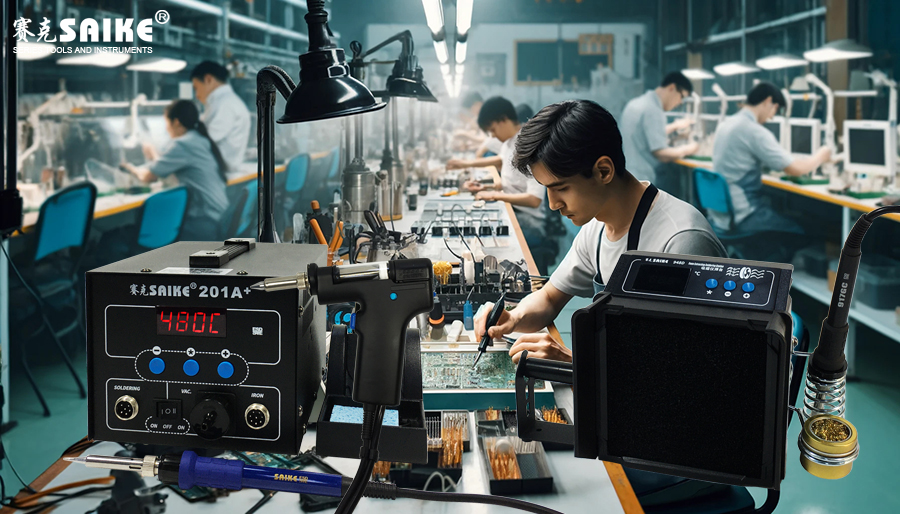
SK-YJ000HT-KP 100010
The soldering station is an indispensable tool in electronic soldering, but various faults may occur during use. This article will introduce the possible faults of the soldering station and their diagnosis and elimination methods in detail, helping users quickly locate and solve problems.
I. The soldering station cannot be started or cannot provide sufficient power.
1.Fault diagnosis:
– The power plug is not properly inserted or loose.
– Power circuit failure, such as transformer, rectifier filter circuit, or voltage regulator IC damage.
2.Elimination methods:
– Check whether the power plug is firmly inserted into the socket.
– Use a multimeter to detect whether there is AC voltage output from the transformer secondary, and check whether the rectifier filter circuit and voltage regulator IC are working normally.
II. The soldering iron tip does not heat up or heats up slowly.
1.Fault diagnosis:
– The wire or connection plug is loose or damaged.
– The heating element (heating wire) is damaged.
– The soldering iron is not properly inserted into the handle.
2.Elimination methods:
– Check and reconnect or replace wires and plugs.
– Use a multimeter to detect the connection between the handle and the soldering station, confirm whether the heating element is intact, and replace it if damaged.
– Re-rotate the soldering iron to ensure a tight fit with the handle spring.
III. The temperature of the soldering iron tip is unstable.
1.Fault diagnosis:
– Temperature sensor failure.
– Damage to the circuit or connecting wire in the control system.
2.Elimination methods:
– Check whether the temperature sensor is working normally, and replace it if necessary.
– Check the circuits and connecting wires in the control system, and repair or replace damaged parts.
IV. The display screen is not bright or displays abnormally.
1.Fault diagnosis:
– The display screen connection cable is loose or damaged.
– The display screen itself is faulty.
2.Elimination methods:
– Check whether the display screen connection cable is secure, and reconnect or replace it if loose or damaged.
– If the connection cable is normal, it may be a fault of the display screen itself, which needs to be replaced.
V. Other common faults and elimination methods.
1.The soldering iron tip cannot be tinned:
– Clean the oxide and impurities on the surface of the soldering iron tip.
– Reset the appropriate temperature.
2.The temperature of the soldering iron tip is too low:
– Reset the appropriate temperature.
– Perform temperature calibration on the soldering iron.
3.The temperature display flickers:
– If it is a brand new soldering iron, it may stabilize after a period of use.
– Check whether the welding spot is too large, leading to abnormal temperature sensing.
VI. Summary
In summary, troubleshooting and elimination of soldering station faults require carefulness and patience. When troubleshooting, follow the principle from the outside to the inside, from simple to complex. For uncertain faults, it is recommended to contact professional maintenance personnel for further inspection and repair to avoid greater losses. Regular maintenance and servicing of the soldering station can extend its service life and reduce the possibility of faults.


